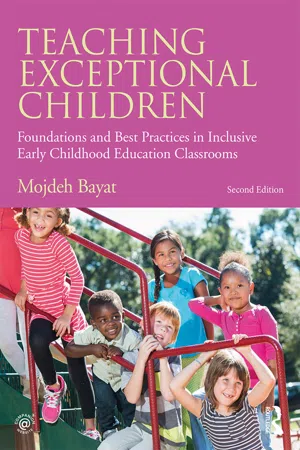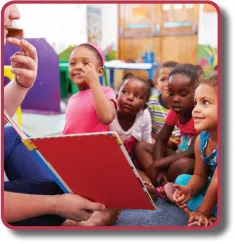
Teaching Exceptional Children
Foundations and Best Practices in Inclusive Early Childhood Education Classrooms
- 598 pages
- English
- ePUB (mobile friendly)
- Available on iOS & Android
Teaching Exceptional Children
Foundations and Best Practices in Inclusive Early Childhood Education Classrooms
About this book
Teaching Exceptional Children isan ideal textbook for introductory graduate and undergraduate courses on early childhood special education and teaching in inclusive classrooms.Bayat's clear and accessible writing, a visually appealing design, and focused pedagogy in each chapter help make it possible to cover a significant amount of material. This powerful text identifies specific behavioral characteristics and presents theoretical information grounded in neuroscience and child development research for a wide range of disabilities. Research-based best practices for effectively working with children with various disabilities in inclusive classrooms are provided in each chapter. The second edition has been fully updated based on the DSM-5, and includes new sections on contemporary issues in inclusion of children with disabilities in early childhood classrooms, such as challenging behaviors, using technology, at-risk children, promoting mental health, and family issues.
A robust pedagogical program, along with online resources for instructors and students, provides full support, including:
-
- Chapter Objectives and Key Terms help frame each chapter
- Discussion, Critical Thinking, Essay/Short Answer, and Review Questions at the beginning, throughout, and concluding chapters prompt students to fully engage with the material
- Homework/Field Assignments provide opportunities for students to apply their knowledge to real-world situations
- Real-Life Vignettes illustrate concepts in action
- Color Photos, Figures, and Tables clarify concepts in a visually engaging way
- Recommended Resources and References offer guidance for further study
-
The companion website, http://routledgetextbooks.com/textbooks/9781138802209, includes instructor resources for teaching and planning, including an Instructor's Manual with additional ideas for assigntments and projects, web links, and video links with reflection questions; a test bank; and PowerPoint lecture slides. The site also includes tools for students to engage with and master the concepts and terminology introduced in the book.
Frequently asked questions
- Essential is ideal for learners and professionals who enjoy exploring a wide range of subjects. Access the Essential Library with 800,000+ trusted titles and best-sellers across business, personal growth, and the humanities. Includes unlimited reading time and Standard Read Aloud voice.
- Complete: Perfect for advanced learners and researchers needing full, unrestricted access. Unlock 1.4M+ books across hundreds of subjects, including academic and specialized titles. The Complete Plan also includes advanced features like Premium Read Aloud and Research Assistant.
Please note we cannot support devices running on iOS 13 and Android 7 or earlier. Learn more about using the app.
Information
Part I
Foundations of Early Childhood Special Education
 | An Introduction to the Field of Early Childhood Special Education | 1 |
Objectives
- Describe who children with exceptional needs are;
- Understand the various programs under Early Childhood Education, Early Childhood Intervention, and Early Childhood Special Education (ECSE) in which children with disabilities and their families are served;
- Describe the role of various professionals in the field of ECSE;
- Understand and analyze the historical developments that shaped the field of ECSE;
- Understand and analyze the legal foundation of special education and the laws which shaped ECSE;
- Evaluate the provisions of the Individuals with Disabilities Education Act as it relates to Early Intervention and Special Education for young children;
- Define inclusion and understand arguments for and against inclusion in early childhood education;
- Understand and analyze the important research which has shaped ECSE;
- List recommendations for ECSE and Inclusive Programs.
Key Terms
- Americans with Disabilities Act (ADA)
- Assistive Technology
- children at risk
- children with special needs
- compensatory/prevention programs
- developmental delay
- due process hearing
- Early Childhood Education (ECE)
- Early Childhood Intervention (ECI)
- Early Childhood Special Education (ECSE)
- Early Intervention (EI)
- Elementary Special Education
- evidenced based/scientific research based
- exceptional children
- experimental
- free and appropriate public education (FAPE)
- giftedness
- Head Start
- inclusion
- inclusive classrooms
- Individualized Education Plan (IEP)
- Individualized Family Service Plan (IFSP)
- Individuals with Disabilities Education Act (IDEA)
- Infant/Early Childhood Mental Health (IMH)
- least restrictive environment (LRE)
- mixed methodologies
- natural environments
- No Child Left Behind Act (NCLB)
- qualitative research
- quantitative research
- quasi-experimental
- regular or general education classrooms
- Rosa’s Law
- special education
- special education classrooms
- transition
Discussion Questions
- Who are children with special needs?
- What is special education?
- In your opinion, what should an early childhood educator know before working with a child with special needs?
- In your opinion, what kind of support and services should be available to teachers who work with children with disabilities?
- What is your position about inclusion of children with disabilities? Why?
Introduction
History of Education of Young Children With Special Needs
Early Pioneers in Special Education
Itard
- To interest him in social life by making it more pleasant to him,
- To help him experience different sensory stimulations,
- To extend the range of his ideas by giving him new needs and by increasing his social contacts,
- To lead him to use speech through imitation,
- To help him use problem-solving skills.
Seguin
Howe
Table of contents
- Cover
- Title
- Copyright
- Dedication
- Contents
- Preface
- Acknowledgments
- Part I Foundations of Early Childhood Special Education
- Part II Disabilities: Diagnosis, Characteristics, and Best Practices
- Part III Kindergarten Through Third Grade
- Glossary of Terms
- Index